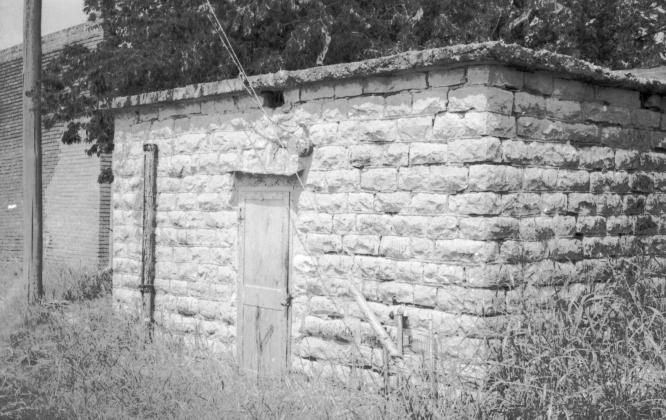The Dublin City Jail was built in 1889 and was similar to those found in the American West. These small jails were called calabooses. It was located in the alley between the Dublin Bottling Works and what is now Celebration Park. I had a chance to see inside while I was working with Wilma Hall in 1971.
The building was surprisingly small inside. It had two jail cells side by side on the back wall of the building. Each cell had its own door. The doors were made with woven metal strapping. The front door to the outside was solid metal, so the jail was secure. The back wall of the building was close to the brick wall of Foust Lumber Yard. Concrete made the roof secure. It was made during the building boom in downtown Dublin in the spring of 1889. The rock must have come from the same quarry as many of the downtown buildings.
An article in the newspaper suggested that after it was built, all were waiting to see who would be the first fellow to be stuck in it. (Dublin Progress, May 11, 1889) The jail was located only a block or so from the local saloon and pool hall, so the pathway between the two buildings was probably well worn. A newspaper report said, “A railroad man was fined $6.25 this week for using obscene language and not thirty minutes later he was lodged in the calaboose for drunkenness.” (Dublin Progress, October 19, 1889)
After looking at a number of articles published over the years, it seems most of the offensives were drunkenness and rowdy behavior. This seemed to happen most often during the reunion held each year. Most were put in one of the cells and later fined and then released. (Dublin Progress, August 5, 1904) (Dublin Progress, August 20, 1937)
A few murder suspects were locked up over the years. Also, a creative thief stole a 5 passenger Buick in Brownwood and thought he had gotten away, until he reached Dublin. He met up with the six shooters of Deputy Sheriff Gibbs and was placed in the calaboose and later turned over to the Brownwood sheriff. The car was returned to Druggest, Hallum of Brownwood. (Dublin Progress, June 13, 1919)
Could a new jail have been built in 1898? This article suggests that it may have been rebuilt or improved on. “The matter of a new calaboose was referred to the police committee with instructions to investigate plans and costs and report at the next meeting.” (Dublin Progress, December 24, 1897) Later, the Progress reported, “The quietude of the city has been something almost marvelous since the grand jury has convened and the new calaboose has assumed such an imposing and substantial appearance.” (Dublin Progress, May 27, 1898)
As time passed, there must have been a number of guys placed in the calaboose and fined and released. The 1891 City Warrants paid because of the calaboose totaled $192.20. (Dublin Progress April 25, 1891)
“An Irishman who had in some manner secured enough intoxicating beverage to think he could whip the entire town by sections or collectively, was taken care of Monday evening by Officers Jackson and Goodwin. He was detained in the calaboose overnight and fined the following morning. (Dublin Progress, September 1, 1899)
The 1902 Sanborn insurance maps show the calaboose building was next to the fire station. The fire station in 1902 was a wood frame building that held 2 hand carts that carried 2 1/2 inch hose. It also housed a hook and ladder hand truck. The Sanborn maps also show 14 ”at each corner. That may have indicated the calaboose rock walls were 14 ” thick.

